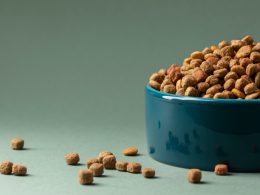The human and dog relationship is so deep that these animals are increasingly considered members of families. Thus concern for health and welfare is a priority for the owners of these animals. Branch companies are aware of the concerns of dog tutors, so they are launching products aimed at the health and welfare of these pets. Thus, many dog-specific products arrive on market shelves daily, especially in the pet food sector. Become a complex task with wide varieties available. In this article, you will understand all about dog food and the importance of maintaining good health, providing well-being, and increasing the longevity of your furry friend.
The Surprising Science Behind Your Dog’s Digestive System
Domestic dogs (Canis lupus familiaris) are members of the family Canidae, the same family as wolves and coyotes. And they are classified as opportunistic carnivores; they are predators with omnivorous tendencies, as they feed preferentially on meat but also can digest other foods such as fruits and vegetables. Contrary to what many think, dogs should ingest plant sources in their food to promote intestinal health and the maintenance of beneficial bacteria present in the digestive tract. Despite having many teeth, dogs do not chew food because their canine teeth and incisors have the function of grabbing and cutting food, so chewing is slight or non-existent.
The Ultimate Guide to Choosing the Best Dog Food for Your Furry Friend
Dog food currently seeks, in addition to nourishing, to promote health, well-being, and longevity. However, the vast amount of commercial ready-to-eat foods, with increasingly sophisticated formulations and different presentations, can cause many doubts, making dog owners prone to making mistakes when choosing food.
The most common types of complete dog food are dry, wet, and natural, which must be recommended and prescribed by a professional dog and cat nutrition specialist. Also, specific foods must be provided as a pleasure, as they do not have all the nutrients that dogs need. The best-known are treats, pâtés, and soft chews.
- Dry dog food: is easy to find and is more cost-effective; the vast majority are affordable and can be stored for an extended period due to the low amount of moisture in the food and the presence of synthetic preservatives.
- Wet dog food: is relatively more expensive than dry food, has a high moisture content, favors the animals’ water intake, and is highly recommended for dogs with kidney problems.
- Natural food: is the new trend of the moment, also known as homemade food; as long as a specialized professional formulates it, it is excellent in terms of palatability and has a high moisture content. Dogs love it, but great care must be taken in the preparation and storage, as there is no addition of synthetic preservatives, storage time is reduced, and it is more expensive than other types of food.
- Coadjuvant food: can be dry or wet, also known as therapeutics, are intended to treat and monitor specific problems, such as allergies, and gastrointestinal and heart diseases.
Quality Matters: Understanding the Different Classifications of Dog Food
- As for the quality
The different types of food have market classifications that differentiate the products according to their quality and can be divided into a standard, premium, and super premium. This classification is defined according to the quality of the ingredients used to make dry, wet, or natural food. It is differentiated according to the source of origin of the proteins, lipids, and carbohydrates, as well as the additives, which are ingredients used to increase food safety and quality of life for dogs.
- As for the age group
Foods are also classified according to the life stage of dogs: puppies, adults, and seniors. This classification is the most important to be respected because each age group demands different levels of nutrients. The lack or excess of these can cause several future problems, especially for the puppies.
- As for the size of the dog
There are morphological differences concerning the size of dogs. In general, they are classified as small, medium, and large. Therefore, the different feed formats were developed to suit all types and sizes of dog breeds and better adapt to their particularities, such as mouth size, muzzle length, and preference for the size and texture of kibbles. It should be noted that the differences between these foods are not only in the formats but also in the concentration of nutrients and energy level per lb of the product, which is adjusted according to the size of each category.
Avoid Common Mistakes: Expert Advice on Choosing the Perfect Dog Food
Choosing the ideal food can become a complex task with many options and classifications. Choosing the perfect food for your dog will depend on several factors, such as purchasing power, age, and whether it is a healthy dog. The idea is to seek help from a professional specializing in dog nutrition which will guide you to provide the best food according to all factors, but if you choose to choose without professional help, follow these tips:
- Choose the food that fits your budget: remember that all rations, including standard rations, are complete and balanced foods made specifically for dogs so they won’t lack any nutrients.
- Do not alter the food you provide, as this will lead to gastrointestinal problems. If you are going to do so, change your dog’s diet, so intestinal flora does not undergo sudden changes.
- Avoid providing feed in bulk; these foods are left out of the original packaging, exposed to moisture, and wrongly packaged, resulting in a loss of food quality.
- Choose foods with well-known brands, and quality control is usually better in established companies.
- Priority order: Despite the wide variety of dog food products, it’s essential to know what to prioritize if you can’t find the right food. Prioritize buying age-appropriate food, then size, and finally targeted foods (such as neutered and indoor). For example, if you have a neutered Daschund puppy that lives indoors, in this case, opt for a bit of puppy food instead of one specific to Daschund or neutered animals.
- If you provide natural food made at home, opt for seasonal foods, as it will lower the cost of food. Remember that foods for human consumption are excellent. However, they have nutrients in smaller amounts than dry and wet food, which are concentrated foods. Therefore, it is necessary to supplement minerals and vitamins, such as calcium and phosphorus. Look for a qualified professional to formulate a meal that will meet all your animal’s nutritional needs.
With all this information, choosing the best food for your buddy will be more accessible according to your financial condition and your dog’s individuality. Always remember that in case of any doubt, you can count on the help of professionals trained in animal nutrition like me.














